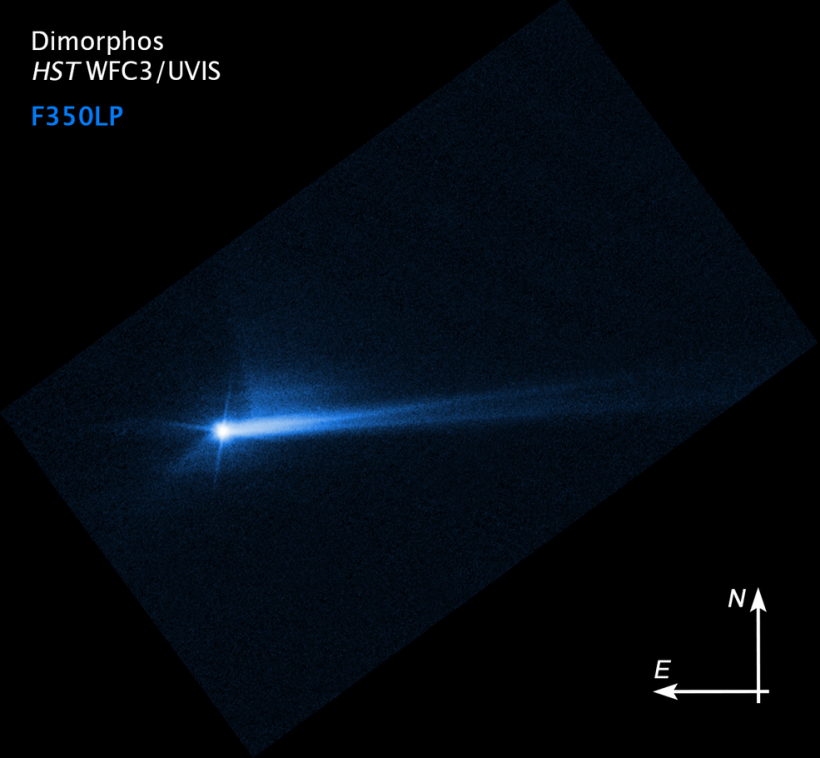New images of NASA's Double Asteroid Redirection Test (DART) spacecraft struck hitting an asteroid were released, allowing scientists to study the aftermath of the collision further. Scientists from the University of Edinburgh are studying the debris left and how it clumped together to form a vast dust cloud.

This imagery from NASA’s Hubble Space Telescope from Oct. 8, 2022, shows the debris blasted from the surface of Dimorphos 285 hours after the asteroid was intentionally impacted by NASA’s DART spacecraft on Sept. 26. The shape of that tail has changed over time. Scientists are continuing to study this material and how it moves in space, in order to better understand the asteroid.
Evolution of Dust Cloud From the DART Mission
This month, NASA revealed that the DART mission managed to shave 33 minutes off the orbit of Dimorphos, which is almost five times more than predicted, deeming the mission a success.
Now, MailOnline reports that the dust cloud from the remnants of the collision after DART which careered into Dimorphos at 14,000 miles per hour (22,000 kilometers per hour) is being studied to learn new insights into how the solar system formed.
Brian Murphy, a Ph.D. student at the university, said that asteroids are some of the basic relics of the planets and moons in the solar system. Researchers also noted that the dust cloud could provide more information about the chemical composition of these astronomers.
Dr. Cyrielle Opitom, an astronomer, added that asteroid impacts happen naturally so they tend to be unpredictable. But the DART mission is a great opportunity to study a controlled impact that is almost like studying it in a laboratory.
For their study, titled "Morphology and spectral properties of the DART impact ejecta with VLT/MUSE" published in the Astronomy & Astrophysics, researchers used the European Southern Observatory's Very Large Telescope (VLT) to observe the DART mission. They observed the resulting debris for a month using the Multi Unit Spectroscopic Explorer (MUSE) instrument at the VLT in Chile.
The team discovered that the blue dust cloud from the collision indicated it was made up of very fine particles. But these particles became clumps, spirals, and a long tail that extended away from the Sun's radiation. Now, the tail looks redder than the original dust cloud, which suggests that there were made up of bigger particles.
MUSE also enabled scientists to investigate the chemical makeup of Dimorphos based on the dust it expelled. Various wavelengths of sunlight are reflected by specific molecules, such as water (H2O) and oxygen (O2), allowing their identification. These two chemicals would indicate the existence of ice within the asteroid, but none of them were discovered.
READ ALSO: NASA James Webb, Hubble Space Telescope Capture Impact of DART Asteroid Impact [LOOK]
What Did the Impact Do to the Asteroid?
Aside from the dust cloud, another team also studied what the collision did to the asteroid. Researchers from the Armagh Observatory and Planetarium used another VLT instrument to investigate the effects of the DART spacecraft on Dimorphos. They found that the sunlight partially polarizes it.
The study published in Astrophysical Journal Letters showed the polarization of the light reflected by the asteroid. Study author Dr. Stefano Bagnulo said that tracking it reveals the structure and composition of Dimorphos. They found that the light reflected on the surface became less polarized, revealing untouched material with a more symmetrical molecular structure.
But since the asteroid also reflected more light after the impact, scientists said it could also suggest that the inner material is smoother than the rough exterior. It could be due to the inner structure's lack of exposure to solar wind and radiation that it is smoother than the exterior.
RELATED ARTICLE: NASA's Hubble Space Telescope Captures Dramatic Hour-by-Hour Changes of Dart Mission Slamming on an Asteroid
Check out more news and information on Space in Science Times.














